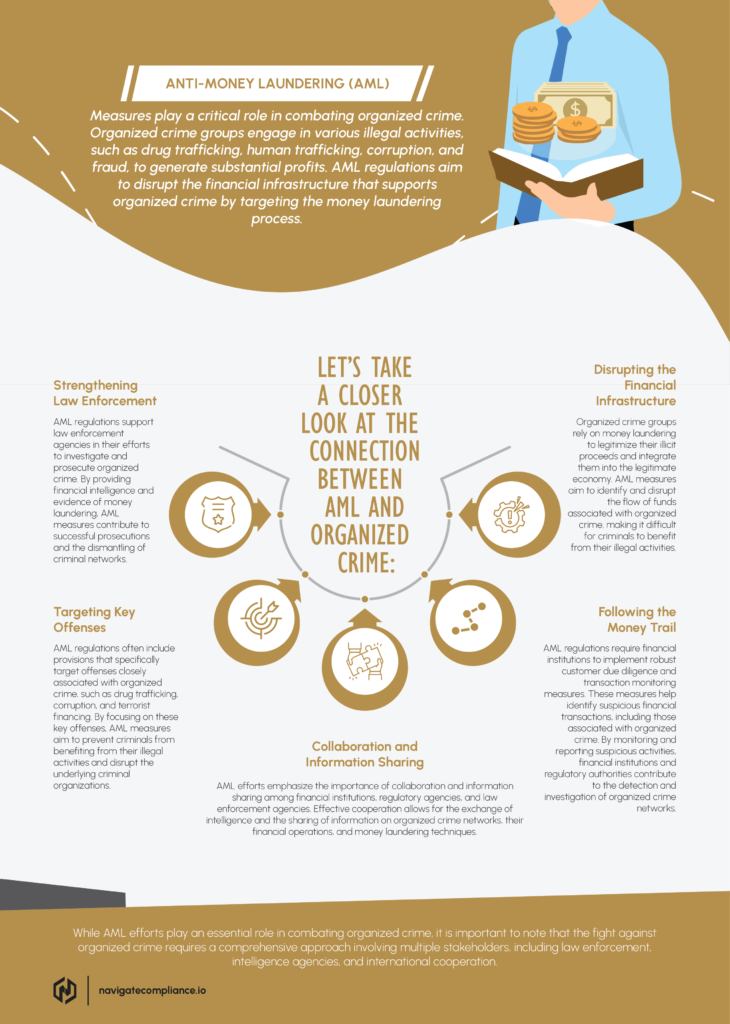The connection between Money laundering and Organized Crime.
Organized crime involves a network of individuals or organizations collaborating, typically in a structured and hierarchical fashion, to conduct unlawful activities. Such activities may include drug trafficking, human trafficking, arms smuggling, fraud, corruption, cybercrime, among others. The profits from these criminal endeavors are often laundered to integrate into the legitimate financial system without attracting attention.
Money laundering is an essential component of organized crime. Criminal organizations generate huge sums of money through their illegal activities, but they face a major challenge: they cannot easily spend or invest this money without attracting attention from law enforcement agencies. It provides a solution to this problem by creating a legal and “clean” trail for the illicit funds.
Money laundering involves various techniques used by criminals to legitimize illicit funds. Here are some common methods:
- Structuring (Smurfing):
- Criminals break down large sums of money into smaller, less suspicious transactions. These transactions occur just below the reporting threshold set by financial institutions.
- For example, they might deposit R9,000 in cash multiple times instead of a single R90,000 deposit.
- Shell Companies:
- Criminals create fictitious companies (shell companies) to move money. These companies have no real business operations but exist on paper.
- Funds are transferred between legitimate businesses and shell companies, making it difficult to trace the origin.
- Trade-Based Laundering:
- Criminals manipulate international trade transactions. They overstate or understate the value of goods or services to move money across borders.
- For instance, an exporter might inflate the value of goods shipped to another country, allowing the recipient to receive excess funds.
- Real Estate Transactions:
- Criminals invest in real estate to launder money. They purchase properties using illicit funds and then sell them, legitimizing the proceeds.
- Real estate transactions can be complex and involve multiple parties, making it challenging to trace the source of funds.
- Digital Currencies (Cryptocurrencies):
- Cryptocurrencies provide anonymity, making them attractive for money laundering. Criminals convert illicit funds into cryptocurrencies and then back into fiat currency.
- Mixing services and privacy coins further obscure the trail.
- Layering:
- Layering involves creating intricate transactions to confuse investigators. Funds move through multiple accounts, countries, and financial instruments.
- The goal is to distance the money from its illegal source.
- Cash Smuggling:
- Criminals physically transport large amounts of cash across borders. They use couriers or hide money in luggage, vehicles, or shipments.
- Smuggled cash is then deposited into financial institutions.
- Gambling and Casinos:
- Criminals use casinos to launder money. They exchange cash for chips, gamble, and then cash out with “clean” funds.
- Casinos’ high volume of transactions and minimal due diligence facilitate this process.
- Front Companies:
- Criminals set up legitimate businesses (front companies) to launder money. These businesses engage in real transactions but also process illicit funds.
- Examples include restaurants, retail stores, or import/export companies.
- Offshore Accounts and Tax Havens:
- Criminals open accounts in countries with strict bank secrecy laws. These jurisdictions make it challenging for authorities to access account information.
- Funds are moved offshore, away from prying eyes.
Remember that anti-money laundering (AML) regulations aim to detect and prevent these techniques. Financial institutions, law enforcement, and regulatory bodies collaborate to combat money laundering effectively.
Combating organized crime and money laundering demands a unified effort from all involved parties. By reinforcing Anti-Money Laundering (AML) structures, improving global collaboration, and remaining alert in the battle against financial crime, we can persist in making substantial progress in preserving the integrity of the international financial system and shielding society from the detrimental impacts of organized crime.
💡 Remember, awareness and understanding are key in combating these issues. Let’s stay informed and work together to create a safer and more secure future.

Read more about the connection between money laundering and organised crime.
Money Laundering: The Beating Heart of Organised Crime | Royal United Services Institute (rusi.org)




